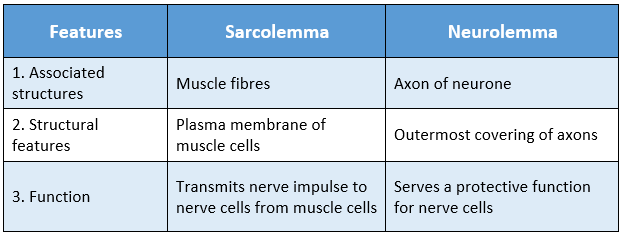Chapter 2 Levels Of Organization Of Life Plant Tissue And Its Distribution Long Answer Type Questions
Question 1. What is meant by tissue? How plant tissues can be classified into different types?
Answer:
Tissue:
Tissue is the assemblage of a number of structurally similar or dissimilar cells having the same origin and function.
Classification of different plant tissues:
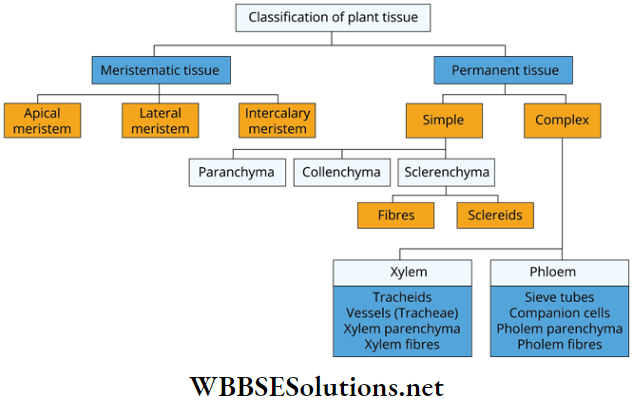
Wbbse Class 9 Life Science Solutions
Question 2 What is meant by meristem or meristematic tissue? Describe the characteristic features of the meristematic tissue with a simple diagram.
Answer:
Meristem or meristematic tissue:
Meristems or meristematic tissues are cells or groups of cells that are capable of undergoing cell division.
Characteristic features of meristematic tissue
The characteristic features of meristematic tissue are as follows:
1. Cells are living, undifferentiated, polygonal, spherical, or oval in shape.
2. Cells are densely packed and without intercellular spaces.
3. The cell wall is thin, made up of cellulose.
4. The nucleus is large and distinct.
5. The cytoplasm is dense, and vacuoles are generally absent.
6. The cells are capable of undergoing cell division.
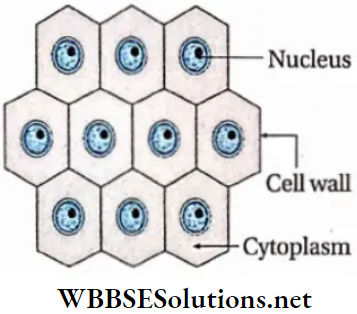
Question 3 Describe the distribution of different meristematic tissues with their functions and support your answer with a diagram.
Wbbse Class 9 Life Science Solutions
Answer:
Distribution of meristematic tissues:
Based on occurrence, meristematic tissues can be sub-divided into three types, which are as follows:
1. Apical meristem: It occurs at the tip of roots and shoots.
Function: Apical meristem gives rise to the primary plant body and helps the root and shoot of the plant to grow in length.
2. Intercalary meristem: It occurs near the nodes of growing shoots, in between two layers of permanent tissues.
Function: This makes the young internodes longer and also helps in the growth of leaves.
3. Lateral meristem: It occurs along the lateral position of roots and stems of higher plants. It divides laterally and makes the plant thicker.
It is of two types:
1. Vascular cambium (fascicular cambium): It occurs within the vascular bundle.
2. Cork cambium (phellogen): It occurs outside the vascular bundle.
Function: Vascular cambium helps in the formation of secondary xylem and secondary phloem tissues and cork cambium is responsible for secondary growth that replaces the epidermis in roots and stems.
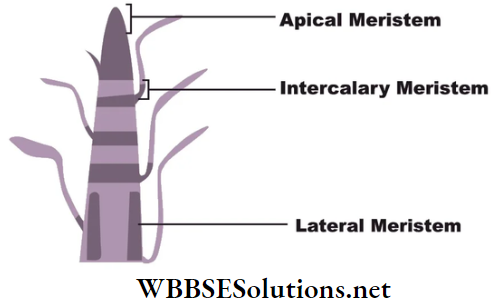
Question 4. What is meant by permanent tissue? Mention its distribution, characteristics and functions.
Answer:
Permanent tissues:
The plant tissues in which cells have lost their capability of undergoing cell division are known as permanent tissues.
Distribution of permanent tissue:
According to the function, permanent tissues are located in various regions within a plant body. simple permanent tissues are found below the epidermis. Parenchyma is found in the mesophyll of leaves and in the cortex of the stem and root. Collenchyma is generally found in the leaf stalks and leaf midribs.
Sclerenchyma is found in stems around the vascular bundles, hard covering of seeds and nuts, and in the leaf veins. Complex permanent tissues can be found throughout a plant body.
Wbbse Class 9 Life Science Solutions
Characteristics of permanent tissue:
1. Cells of these tissues do not divide any further.
2. These are mature cells, so they have attained definite size, shape, structure and perform a particular function.
3. Cells have larger vacuoles. Intercellular spaces are often present.
4. Cell walls are comparatively thick. Often ornamentations are present on cell wall.
5. These tissues comprise of either dead or living cells. In living cells, smaller nucleus with reduced protoplasm is observed.
6. Metabolic rate within the cells of this tissue is slower in comparison to that of meristematic cells.
Function: These tissues are involved in protection, support, transportation or secretion.
Question 5. Classify simple permanent tissue by describing the characteristic features of each.
Answer:
Classification of Simple Permanent Tissue:
On the basis of their shapes, simple permanent tissues are classified into three groups-parenchyma, collenchyma, and sclerenchyma.
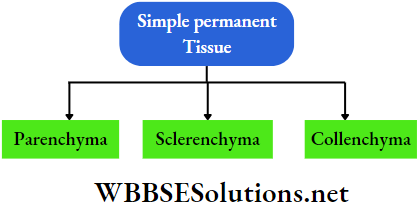
1. Parenchyma:
1. Cells are spherical, oval, or polyhedral.
2. Cell wall is thin and made up of cellulose.
3. Cells living with dense protoplasm.
4. Cell contains distinct nucleus and vacuoles.
5. Cells are with intracellular spaces.
6. Cells are of three types:
1. Chloroplast containing chlorenchyma
2. Air cavity containing aerenchyma
3. Tanins, oils and calcium oxalate crystal containing idioblast.
2 Collenchyma:
1. Simple tissue consisting of unevenly thick-walled living cells.
2. On the basis of cell wall thickenings, collenchyma is of the following three types:
1. Lamellar or plate-like
2. Lacular or tubular
3. Angular.
3. Sclerenchyma:
1. Simple tissue consisting of evenly thickened-walled dead cells.
2. Cell wall contains lignin.
3. It is of two types:
1. Sclerenchyma fibers.
2. Sclereids.
Wbbse Class 9 Life Science Solutions
Question 6. Describe the characteristic features of parenchyma tissue with simple diagram. Mention its functions in a plant body.
Answer:
Characteristic features of parenchyma tissue:
The characteristic features of parenchyma tissue are as follows:
1. Cells are living and thin-walled, almost equal in size and shape.
2. Cells are loosely packed with distinct intercellular spaces.
3. Vacuoles are large. Cytoplasm becomes peripheral, forming a primordial utricle with a distinct nucleus.
Functions of parenchyma tissue:
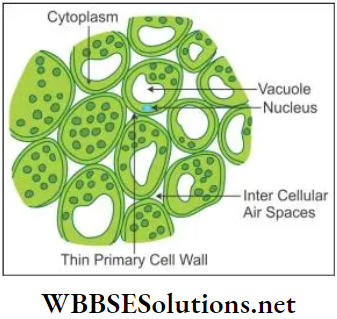
The functions of parenchyma tissue are as follows:
- Simple parenchyma cells occur in the ground tissue and store food.
- Aerenchyma maintains buoyancy in floating and submerged aquatic plants.
- Chlorenchyma takes part in photosynthesis.
- Idioblasts store mineral crystals, oil, excretory matter, etc.
- Parenchyma cells take part in gaseous exchange which can be performed because of the presence of intercellular spaces.
- In the form of epidermis or epiblema, parenchyma protects all plant parts.
Question 7. Describe the characteristic features of collenchyma tissue with a diagram. Mention the function of this tissue.
Answer:
Characteristic features of collenchyma tissue:
The characteristic features of collenchyma tissue are as follows:
1. Cells are living and are of almost identical size. They are cylindrical, but in cross-section, appear polygonal.
2. Cell wall is made up of cellulose, hemicellulose, and pectin. The cell wall is unevenly thickened at the corners.
3. Less intercellular space is present.
4. Vacuole is large. The cytoplasm is present as a primordial utricle.
5. Chloroplast may be present.
Functions of collenchyma tissue:
The functions of collenchyma tissue are as follows:
1. Collenchyma tissue provides mechanical strength.
2. It provides flexibility to plant parts and prevents them from breaking.
3. This type of tissue helps to store food.
4. It also carries out photosynthesis.
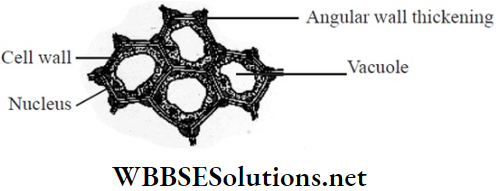
Wbbse Class 9 Life Science Solutions
Question 8. Describe the characteristic features of sclerenchyma tissue. Mention the functions of this tissue.
Answer:
Characteristic features of sclerenchyma tissue:
The characteristic features of sclerenchyma tissue are as follows:
1. Mature Cells are dead, devoid of protoplasm and have a narrow lumen.
2. Cells are without inter-cellular space.
3. The cell wall is evenly thickened and highly lignified.
4. In some places, pits are present on the cell wall.
5. Some cells are thin, elongated and pointed. These are called sclerenchyma fibres. Some are wide with very thick cell wall, which are called sclereids.
Functions of sclerenchyma tissue
The functions of sclerenchyma tissue are as follows:
1. Sclerenchyma tissue provides mechanical strength.
2. It makes the plant parts rigid.
3. Sclereids especially form tough seed coats of legume fruits and the endocarp of a drupe.
4. This tissue also protects plant parts from getting wet.
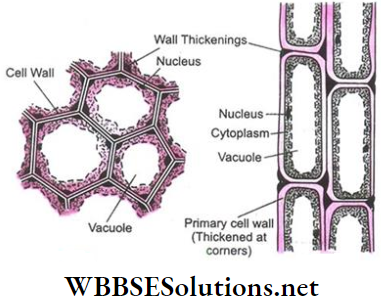
Wbbse Class 9 Life Science Solutions
Question 9. Write down the structure of sclerenchyma fibres.
Answer:
The structure of sclerenchyma fibres is as follows:
1. Sclerenchyma fibres are very fine and long with two pointed ends.
2. Cells are without intercellular spaces and are compactly arranged sidewise to form bundles.
3. The cell wall is evenly thickened with bordered pits and the lumen is narrow.
4. Cells are dead and appear polygonal in cross-section.
5. The sclerenchyma fibres occurring in the xylem are called wood fibres. These fibres, when occur in phloem are called bast fibres.
Question 10 Compare the characteristic features of parenchyma, collenchyma and sclerenchyma.
Answer:
Comparison among parenchyma, collenchyma and sclerenchyma:
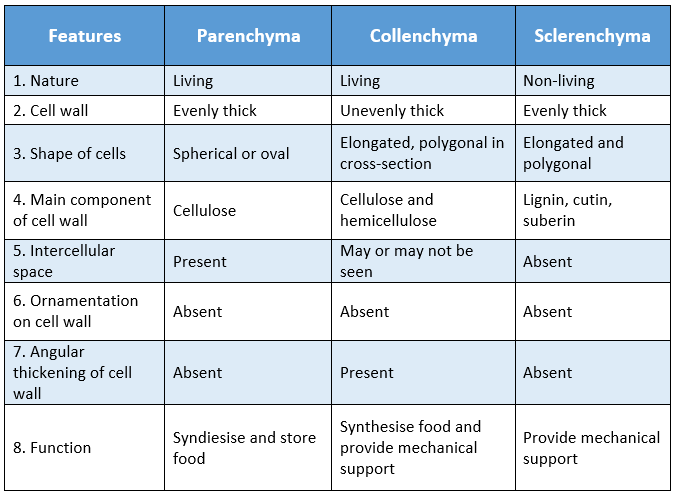
Question 11 Mention the living and non-living components of the xylem. Write down its function.
Answer:
Components of Xylem:
Xylem has four typical components. These are the tracheid, tracheae or vessels, xylem parenchyma and xylem fibres. Among them, the xylem parenchyma is the living component of the xylem, whereas, the rests are non-living components.
Characteristic features of xylem components:
The characteristic features of xylem components are as follows:
1. Tracheids are dead, elongated cells with two pointed ends. Unevenly lignified thickening of walls creates different patterns. Pits are present in the cell wall. These cells take part in water transportation throughout the plant body.
2. Vessels or tracheae are long, tubular dead cells without end walls. Lumen is wider than that of tracheids. The wall of the vessels possesses many pits. These cells also carry sap. Numerous cells are arranged in a row to form long continuous vessels.
3. Xylem fibres are composed of dead cells, which are very thin & long with pointed ends. The cell wall of xylem fibre is thick with a narrow lumen. These cells provide mechanical strength and rigidity to the plant body.
4. Xylem parenchyma is the only component of the xylem tissue which is composed of living cells. It has a thin cell wall and it contains protoplasm.
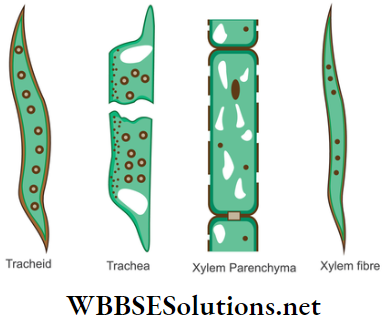
WBBSE Life Science And Environment Class 9 Solutions
Question 12 Give a brief description of the structure of the trachea. Mention the occurrence and functions of the trachea.
Answer:
Structure of tracheae or vessels:
The structure of the tracheae is as follows:
1. These cells are dead, long and tubular in shape with completely or partially open ends.
2. The wall is lignified with bordered pits. Ornamentations are often found on the wall due to uneven thickening.
3. The lumen present here, is the widest among, all xylem components.
4. Several tracheal cells remain arranged one after another to form a continuous tube due to the dissolution of end walls.
Occurrence of tracheae or vessels:
These xylem components occur in all angiosperms and a gymnosperm named Gnetum. Functions of trachea
The functions of the trachea are as follows:
1. It transports sap from roots to leaves.
2. Trachea provides mechanical support to the plant body.
Question 13 Give a brief description of the structure of the Xylem Parenchyma. Mention its occurrence and functions.
Answer:
Structure of xylem parenchyma:
The structure of xylem parenchyma is as follows:
1. These are living cells with cytoplasm and a small nucleus.
2. The cell wall is thin and composed of cellulose.
3. The cells are almost isodiametric and their lateral walls have few simple pits.
Occurrence of xylem parenchyma:
Xylem parenchyma is present in the vascular bundle of all angiosperms and most of the gymnosperms, except pines.
Functions of xylem parenchyma:
The functions of xylem parenchyma are as follows:
1. It helps in the transportation of sap and also helps in lateral transportation.
2. It stores nutrients like carbohydrates, fats and excretory matters like tannin, inorganic crystals, etc.
Question 14. Give a brief description of the structure of Xylem fibre. Mention its occurrence and functions.
Answer:
Structure of xylem fibres:
The structure of xylem fibres is as follows:
1. The cells of xylem fibre are dead, very fine with pointed ends.
2. Cells have very narrow lumen.
3. The cell wall is very thick due to heavy lignification and rigid with both simple and bordered pits.
4. Fibres are of two types-libriform fibre and tracheid fibre.
Occurrence of xylem fibres:
Xylem fibres are present in the vascular bundle of all angiosperms and most of the gymnosperms, except pines.
Functions of xylem fibres:
The functions of xylem fibres are as follows:
1. These provide mechanical support to the plant body.
2. These also store food material and certain excretory matters.
Question 15. What is phloem? Describe the distribution, characteristics and function of phloem.
Answer:
Phloem:
The organic food conducting complex tissue in vascular plants is known as phloem.
These are composed of four elements:
1. sieve tubes
2. companion cells
3. phloem fibre or bast fibre
4. phloem parenchyma.
Distribution/Location:
Phloem is present in vascular bundles of root, stem and leaves.
Characteristics:
1. These are complex, living permanent tissue.
2. All the cell elements of this tissue are living except phloem fibre.
3.
The cell wall is thin, composed of cellulose except for phloem fibre.
Function:
The main functions of the phloem are the conduction of food matters from leaves to different regions of the plant body and its storage.
WBBSE Life Science And Environment Class 9 Solutions
Question 16. Describe the characteristic features of these components.
Answer:
Characteristic features of phloem components:
The characteristic features of phloem components are as follows:
1. Sieve tubes are living cylindrical cells with perforated end walls, called sieve plates. The nucleus is absent in mature cells. Several sieve tubes are arranged in a row forming a long tube. It helps in the transportation and storage of food.
2. Companion cells are lens-shaped cells with prominent nuclei and dense cytoplasm. They are present on either side of the sieve tube. These help sieve tubes in the transportation of food.
3. Phloem parenchyma has granular cytoplasm and a thin cell wall made up of cellulose. This component of phloem stores organic and orgastic materials.
4. Phloem fibre is the only non-living component of phloem. It is elongated with lignified walls. Pits are present in the cell wall. Fibres provide mechanical support to plant parts.
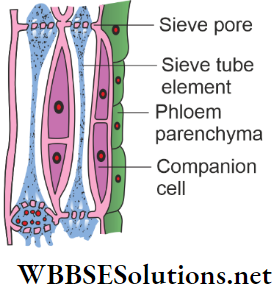
Question 17. Give a brief description of the structure of the sieve tube. Mention its occurrence and functions.
Answer:
Structure of sieve tube:
The structure of the sieve tube is as follows:
1. Sieve tubes are tubular in shape, arranged longitudinally one after another to form a continuous pipe.
2. The matured cells have cytoplasm but no nucleus inside.
3. The wall is thin and composed of cellulose.
4. The two terminal walls are well-perforated and are called sieve plates.
5. The connection between two sieve cells is made by cytoplasmic strands through sieve pores.
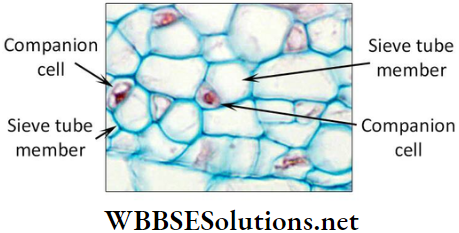
Occurrence of sieve tube:
Sieve tubes are present in pteridophytes and all flowering plants.
Functions of sieve tube:
The functions of sieve tubes are as follows:
1. They help in the transportation of food.
2. They also occasionally store food.
Question 18. Give a brief description of the structure of the companion cell. Mention its occurrence and functions.
Answer:
Structure of companion cell:
The structure of companion cells is as follows:
1. The cells are living, full of dense cytoplasm and with a distinct nucleus.
2. The cells have thin walls, made up of cellulose and appear triangular in cross-section.
3. Laterally, these cells are lens-shaped.
4. These cells keep a close association with the sieve tube through pits and plasmodesmata on the lateral wall.
Occurrence of companion cell:
Companion cells occur in the phloem of all angiosperms and in a single gymnosperm, named Gnetum sp.
Functions of companion cell:
The functions of companion cells are as follows:
1. The help in the transportation of food through a sieve tube.
2. They also store carbohydrates and help in lateral transport.
Question 19. Give a brief description of the structure of phloem parenchyma. Mention its occurrence and functions.
Answer:
Structure of phloem parenchyma:
The structure of phloem parenchyma is as follows:
1. The cell wall is thin and made up of cellulose. It is rarely lignified and pitted.
2. The shape of the cells is elongated, cylindrical and radially arranged with the plant axis.
3. The cytoplasm of these cells stores starch, resin, tannin, etc.
Occurrence of phloem parenchyma:
It can be observed in all dicot plants but monocot plants never possess phloem parenchyma. Pteridophytes and gymnosperms also have these cells in the phloem.
Functions of phloem parenchyma:
The functions of phloem parenchyma are as follows:
1. It helps in food transport.
2. It stores different organic matter and excretory substances.
3. It helps in the lateral transport of organic food matter.
WBBSE Life Science And Environment Class 9 Solutions
Question 20. Give a brief description of the structure of phloem fibre. Mention its occurrence and functions.
Answer:
Structure of phloem fibre:
The structure of phloem fibre is as follows:
1. These cells are non-living, with a very fine and hollow lumen.
2. The cells are long with pointed ends.
3. The cell wall is thick, well-lignified and commonly with simple pits.
4. The cells remain arranged one after another along the length.
2. Fibres are overlapped to form bundle.
Occurrence of phloem fibres:
Phloem fibres are present in angiosperms only.
Functions of phloem fibres:
The functions of phloem fibres are as follows:
1. These provide mechanical support to the plant body.
3. These also store food matter, like starch.
Chapter 2 Levels Of Organization Of Life Plant Tissue And Its Distribution Long Answer Type Questions
Question 1. Describe the structure of epithelial tissue. Mention its functions.
Answer:
Structure of epithelial tissue:
1. The cells are present on a basement membrane made up of collagenous materials.
2. Cells are densely packed and are joined together by mucoproteins (a special type of glycoprotein).
3. Cells of this tissue are either arranged in a single layer or in multilayers.
4. Cells do not get a direct blood supply. They receive oxygen and nutrients from underlying tissues.
Functions of epithelial tissue:
1. Epithelial tissue provides protection to the animal body and its various organs.
2. Epithelial tissue like squamous epithelium, takes part in gaseous exchange.
3. Columnar epithelial cells help in absorption and secretion.
4. Certain cuboidal and glandular epithelial cells secrete enzymes and hormones.
WBBSE Class 9 Life Science Question And Answer
Question 2. Mention the distribution of connective tissue. Briefly mention the structure of connective tissues.
Answer:
Distribution of connective tissue:
1. Areolar tissue is present below the skin, between muscles, outer coatings of nerves and walls of blood vessels.
2. Fibrous tissues are present in tendons, ligaments, walls of arteries, trachea and larynx.
3. Adipose tissue is found below the skin, mammary glands, and surrounding vital organs like the heart, kidney, etc.
4. Bones and cartilage are found in the skeletal parts.
5. Blood and lymph are present in the circulatory system.
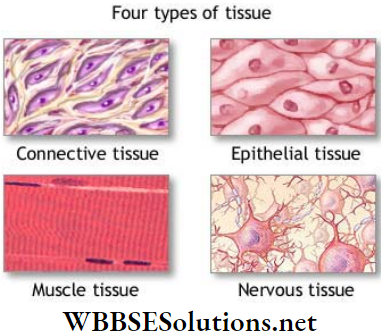
Structure of connective tissue:
1. Connective tissue originates from the mesoderm layer of the embryo.
2. It possesses fewer cells, which remain loosely placed in the intercellular matrix.
3. Cells of connective tissue are of various types with different sizes, shapes, intra and intercellular components and functions.
4. Some fibrous materials like collagen, elastin etc. may be present in the matrix.
5. The matrix may be soft, jelly-like (areolar and adipose tissue), liquid (blood, lymph), rigid (bone), or elastic (cartilage).
Question 3 Briefly describe the structure of muscular tissue. Distinguish between muscular tissue and nervous tissue.
Answer:
Structure of muscular tissue:
1. Muscle cells are commonly called muscle fibres. These are thin, elongated, cylindrical or spindle-shaped.
2. Bundles of muscle fibres, surrounded by connective tissue, constitute a muscle.
3. Muscle fibres may be uninucleated, multinucleated, unbranched or branched.
4. The cytoplasm of muscle cells is called sarcoplasm, which remains surrounded by sarcolemma. Within sarcoplasm, several longitudinal contractile proteins are present, which help in the contraction and relaxation of muscles.
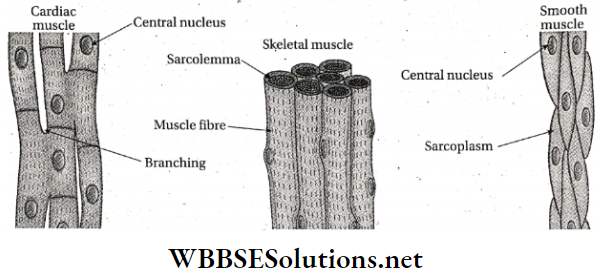
Differences between muscular tissue and nervous tissue:
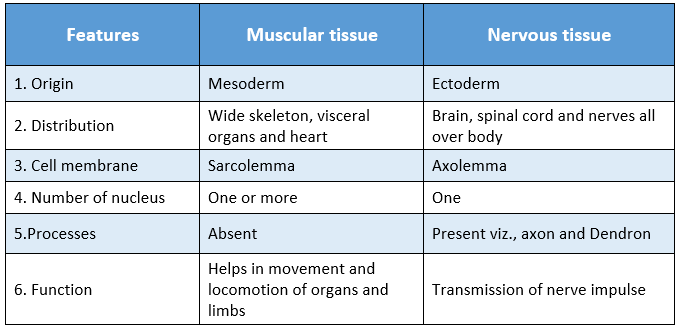
WBBSE Class 9 Life Science Question And Answer
Question 4. Mention the functions of different types of connective tissues. Distinguish between epithelial tissue and connective tissue.
Answer:
Functions of connective tissue:
1. Areolar tissue acts as packing material between the organs.
2. Adipose tissue stores fat for future use, keeps the body warm and acts as a cushion to protect the body against mechanical injury.
3. Bones and cartilages form the skeleton to give mechanical support to the body of the vertebrates.
4. Fibrous tissue provides elasticity and mechanical support.
5. Blood and lymph act as transporting fluid, carrying nutrients, hormones, respiratory gases, etc. to different parts of the body.
Differences between epithelial and connective tissue:
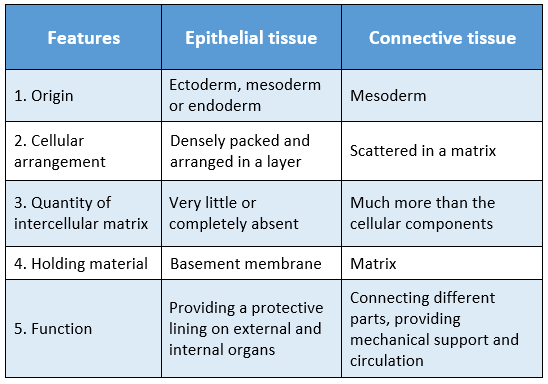
Question 5. Describe the structure of a neurone.
Answer:
Structure of a neurone:
1 Neurone has two parts, the cell body or neurocytoma and some processes.
2 Neurocyton or cell body is covered by a typical cell membrane surrounding the protoplasm.
3 Protoplasm has a distinct nucleus and cytoplasm with various cell organelles.
4 Apart from mitochondria, Golgi body, ER etc., the cytoplasm of a neurone has some nucleoprotein granules, known as nissl granules.
5 Processes of a neurone are axon and dendron.
6 Axon is the longer part with fewer branching. A few axons have an extra thick insulating cover on it, called myelin sheath.
7 Myelin sheath is interrupted by several constrictions. These are called nodes of Ranvier.
8 A special type of cell called Schwann cell, is also found along, the length of the axon.
9 The axon ends with a few branches, commonly called as end brush.
10 The dendron is shorter and well-branched. These branches are known as dendrites.
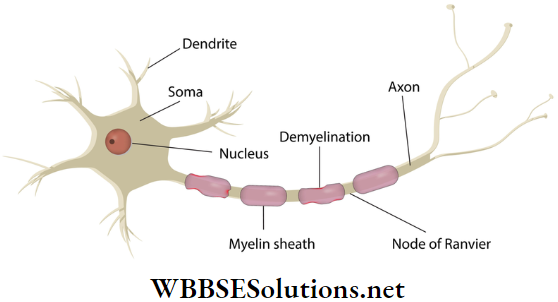
WBBSE Class 9 Life Science Question And Answer
Question 6. Compare the features of voluntary, involuntary and cardiac muscle.
Answer:
Comparison among voluntary, involuntary and cardiac muscle:
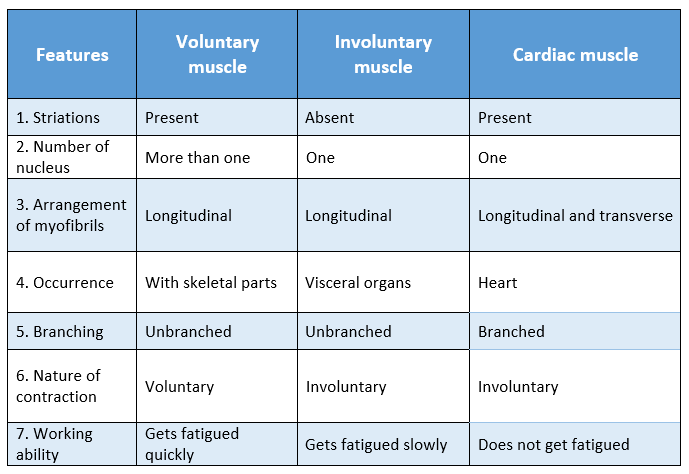
Question 7. Distinguish between:
1. Axon and Dendron
2. Sarcolemma and neurolemma.
Answer:
Differences between axon and dendron:
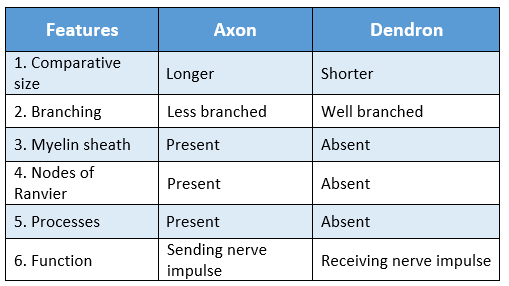
Differences between sarcolemma and neurolemma:
